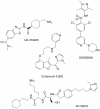Selective inhibitors of protozoan protein N-myristoyltransferases as starting points for tropical disease medicinal chemistry programs
- PMID: 22545171
- PMCID: PMC3335879
- DOI: 10.1371/journal.pntd.0001625
Selective inhibitors of protozoan protein N-myristoyltransferases as starting points for tropical disease medicinal chemistry programs
Abstract
Inhibition of N-myristoyltransferase has been validated pre-clinically as a target for the treatment of fungal and trypanosome infections, using species-specific inhibitors. In order to identify inhibitors of protozoan NMTs, we chose to screen a diverse subset of the Pfizer corporate collection against Plasmodium falciparum and Leishmania donovani NMTs. Primary screening hits against either enzyme were tested for selectivity over both human NMT isoforms (Hs1 and Hs2) and for broad-spectrum anti-protozoan activity against the NMT from Trypanosoma brucei. Analysis of the screening results has shown that structure-activity relationships (SAR) for Leishmania NMT are divergent from all other NMTs tested, a finding not predicted by sequence similarity calculations, resulting in the identification of four novel series of Leishmania-selective NMT inhibitors. We found a strong overlap between the SARs for Plasmodium NMT and both human NMTs, suggesting that achieving an appropriate selectivity profile will be more challenging. However, we did discover two novel series with selectivity for Plasmodium NMT over the other NMT orthologues in this study, and an additional two structurally distinct series with selectivity over Leishmania NMT. We believe that release of results from this study into the public domain will accelerate the discovery of NMT inhibitors to treat malaria and leishmaniasis. Our screening initiative is another example of how a tripartite partnership involving pharmaceutical industries, academic institutions and governmental/non-governmental organisations such as Medical Research Council and Wellcome Trust can stimulate research for neglected diseases.
Conflict of interest statement
The authors have declared that no competing interests exist.
Figures







References
-
- TDR: For Research on Diseases of Poverty. http://apps.who.int/tdr/
-
- TDR: Leishmaniasis. http://www.who.int/tdr/diseases/leish/diseaseinfo.htm.
-
- den Boer M, Argaw D, Jannin J, Alvar J. Leishmaniasis impact and treatment access. Clin Microbiol Infect. 2011;17:1471–1477. - PubMed
-
- Sundar S. Drug resistance in Indian visceral leishmaniasis. Trop Med Int Health. 2001;6:849–854. - PubMed
-
- den Boer ML, Alvar J, Davidson RN, Ritmeijer K, Balasegaram M. Developments in the treatment of visceral leishmaniasis. Expert Opin Emerg Drugs. 2009;14:395–410. - PubMed
Publication types
MeSH terms
Substances
Grants and funding
LinkOut - more resources
Full Text Sources
Other Literature Sources
Research Materials
Miscellaneous

